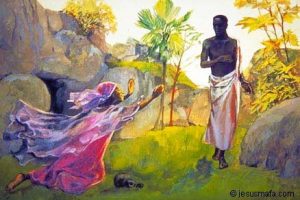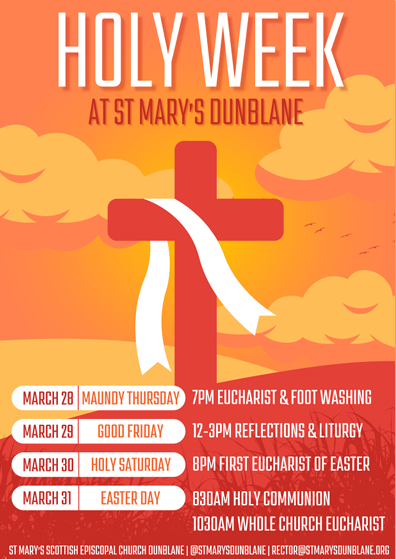Nerys writes: As many of you know, I’ve been putting aside time every day in Lent to work my way very slowly through John’s Gospel. In the process, I have learnt a great deal, not only about this wonderful text but also about myself as a reader. One thing I have discovered is that in order to enter deeper into most of John’s narrative passages, I will very naturally imagine the scene, the people and the events, visually, as a series of paintings which I can examine and explore. Some particular passages, however, demand another approach. For these, I tend to translate what I read into music, imagining the atmosphere, the action, the voices as a series of sounds made by orchestral instruments. John 20.1-18 is one of those special passages which is so rich and mysterious that it calls on us to use more than one of our senses in order to bring it to life and grasp its meaning.
It starts with darkness and, as with every musical composition, with silence. This silence, however, is a prolonged one. After giving us an hour by hour account of the events of the last days of Jesus’ life, the author tells us nothing about the time between the burial of his body and the discovery of the empty tomb. I invite you to stay with that silence for a moment. Is it the absolute silence, stillness, emptiness of death or is it like the silence of night, the silence which proceeds the dawn of a new day? Is it perhaps the same silence as that of Genesis 1, the silence which anticipates Creation, when God’s Spirit hovers noiselessly over the void? The expectant silence we experience as an orchestra waits for their conductor to pick up the baton.
What follows, however, is not the orderly, harmonious progression of the first creation story, but disjointed, stuttering, chaotic rhythms. The empty tomb is discovered. Mary runs, Peter and the other disciple run. (There is more running in these verses than in the rest of the gospels put together.) We hear above the pounding of the feet, Mary’s urgent call full of terror and incomprehension: ‘They have taken the Lord out of the tomb’. And her agonised cry of loss, the cry of all who experience desolation and abandonment: ‘We do not know where they have laid him’.

Image: Mary Magdalene in the Garden by Sieger Koder
As the early morning light grows stronger, the turmoil subsides. Chaos gives way to curiosity as Peter and his companion notice the graveclothes neatly arranged inside the tomb. The unnamed disciple sees and believes. The beginnings of a new tune is heard as hope surges in the young man’s heart. He doesn’t understand yet but he knows deep down that a new world has dawned.
The bright notes of his new-found delight in God’s creative power fade away with the disciples’ hurried return to the city and we are left with the desolate sound of Mary’s sobbing. Stay with the rhythm of her tears as she stands alone at the tomb. It is through those tears that she sees the angels lighting up the gloom. Their question invites her to share the cause of her grief: ‘They have taken away my Lord.’ Hear the grief of our world concentrated in her lament. ‘They have taken away … my home, my family, my rights, my dignity, my freedom, my hope.’
Traumatised and distracted, Mary turns away without waiting for a response. Another figure appears before her, indistinct, unfamiliar. A stranger who repeats the angel’s question and to whom she repeats her cry of loss. A stranger she takes to be the gardener, one she again turns away from in her passionate searching for the dead body of her Lord. And then, cutting through the discordant sounds of her confusion and desperation, two gentle notes: ‘Mary!’ The Good Shepherd calling her by name. Pause to hear Jesus calling you by your name and calling to himself all those who need his love and healing today.

Image: Jesus Mafa Project
The one Mary had seen and mistaken for the gardener she now recognises as her teacher. The tune of delighted astonishment returns as she calls out, ‘Rabbouni’, and opens her arms to hug him. But this is a new relationship, a different kind of intimacy. Jesus is on his way to be one with his Father who is also our Father. The music tingles with new possibilities as Jesus embraces his followers within his family relationship with God. They are no longer his servants or friends, they are his siblings. Their sister Mary is sent to pass on his message to them and to share her own experience: ‘I have seen the Lord!’ Stay with the music of her footsteps as she heads once more towards Jerusalem. This is the very beginning of a tune whose harmony is to grow richer and stronger as more and more come to believe in the risen Lord and entrust themselves to him. This is a tune to which you and I are called to add our voices and our lives.






